About this manuscript
This is the lower part of a folio from the Apocryphal Acts of the Apostles in Sahidic, one of the two most prominent variants of Coptic. The style of writing suggests that it was copied in a monastic scriptorium in Egypt, in the 9th or 10th century. The text on the recto is barely legible, but a Sahidic parallel (Paris, BnF Copte 12918, f. 139), reveals that it is about Jesus who appears to the apostles James and Peter, exhorting them by saying that their suffering will be nothing compared to one hour of rest in the Kingdom of Heaven. The clearly legible text on the verso is part of a story in which James heals a blind man and gets arrested for “sorcery”. There are no parallels for this story in Sahidic, but we know it from the Arabic and Ethiopian versions of the Acts of the Apostles.

Over the centuries, folios of this codex have been dispersed. This one was still accompanied by a full-size folio (inscribed with a section from the apocryphal Acts of Philip and Peter) when they were owned by Erik von Scherling (1907-1956), but they were separated after he died. Through research in archives and catalogues, Alain Suciu was able to link this fragment to two other pieces: part of the central section of this sheet is kept in the Abbey of Montserrat (P. Monts. Roca 323), whereas the full-size folium that previously belonged to Von Scherling, turned up in the Schøyen Collection, where it was catalogued as MS 2007. It was put up for sale again in 2019.
Further reading:
J. Bloom, Paper Before Print, New Haven, Connecticut 2001.
Suciu, A. “Three dispersed fragments from a Coptic manuscript of the Apocryphal Acts of the Apostles”, Bulletin of the American Society of Papyrologists 49 (2012), 241-250.
Worp, K.A., and R. Dekker, “Missing Papyri: The Greek and Coptic Papyri in the Von Scherling Papyrus Collection”, Bulletin of the American Society of Papyrologists 49 (2012), 175-208.
J.J. Witkam, Inventory of Oriental Manuscripts of the Library of the University of Leiden, vol 15, Leiden 2007, 157-158.
Questions
-
On which side is the text better preserved, on the hair or flesh side? Can you think of a reason?
-
What was the approximate original size of the folio and about how many text lines were inscribed on it?
-
The former Schøyen Collection, MS 2007 and Or. 14.331 came to Europe together. How were they separated?
Assignments
-
Recommended font: Antinoou.
Create your own diplomatic edition of Or. 14.331 and P. Monts. Roca 323, using the Leiden system (see the images showing of both sides of the reconstructed folio in Suciu 2012, 250).
-
Compare the traces on the rectos of Or. 14.331 and P. Monts. Roca 323 with the parallel text in Paris, BnF Copte 12918, f. 139a-b, which was edited by O. Lemm (1908, 1325-1326).
